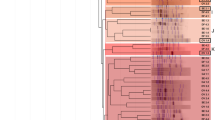A field trial was previously conducted in which sugarbeet seeds were either untreated, inoculated with the biocontrol strain Pseudomonas fluorescens F113Rif, or treated with chemical fungicides. Following harvest of sugarbeet, the field site was sown with uninoculated red clover. The aim of this study was to assess the residual impact of the microbial inoculant (and the fungicide treatment) on the diversity of resident rhizobia nodulating the red clover rotation crop. The percentage of nodules yielding rhizobial isolates after surface disinfection was 67% in the control and 70% in the P. fluorescens F113Rif treatment, but only 23% in the chemical treatment. Isolates were characterized by RAPD analysis. The main RAPD cluster (arbitrarily defined at 70% similarity) was prevalent in all three treatments. In addition, the distribution of RAPD clusters followed a log series model, regardless of the treatment applied, indicating that neither the microbial inoculant nor the fungicide treatment had caused a strong perturbation of the rhizobial population. When the P. fluorescens F113Rif and control treatments were compared using diversity indices, however, it appeared that the genetic diversity of rhizobia was significantly less in the inoculated treatment. The percentage of rhizobia sensitive to 2,4-diacetylphloroglucinol (Phl; the antimicrobial metabolite produced by P. fluorescens F113Rif) fluctuated according to field site heterogeneity, and treatments had no effect on this percentage. Yet, the proportion of Phl-sensitive isolates in the main RAPD cluster was lower in the P. fluorescens F113Rif treatment compared with the control, raising the possibility that the residual impact of the inoculant could have been partly mediated by production of Phl. This impact on the rhizobial population took place without affecting the functioning of the Rhizobium–clover symbiosis.
Similar content being viewed by others
Author information
Authors and Affiliations
Rights and permissions
About this article
Cite this article
Walsh, U., Moënne-Loccoz, Y., Tichy, HV. et al. Residual Impact of the Biocontrol Inoculant Pseudomonas fluorescens F113 on the Resident Population of Rhizobia Nodulating a Red Clover Rotation Crop . Microb Ecol 45, 145–155 (2003). https://doi.org/10.1007/s00248-002-2026-8
Received:
Accepted:
Issue Date:
DOI: https://doi.org/10.1007/s00248-002-2026-8




